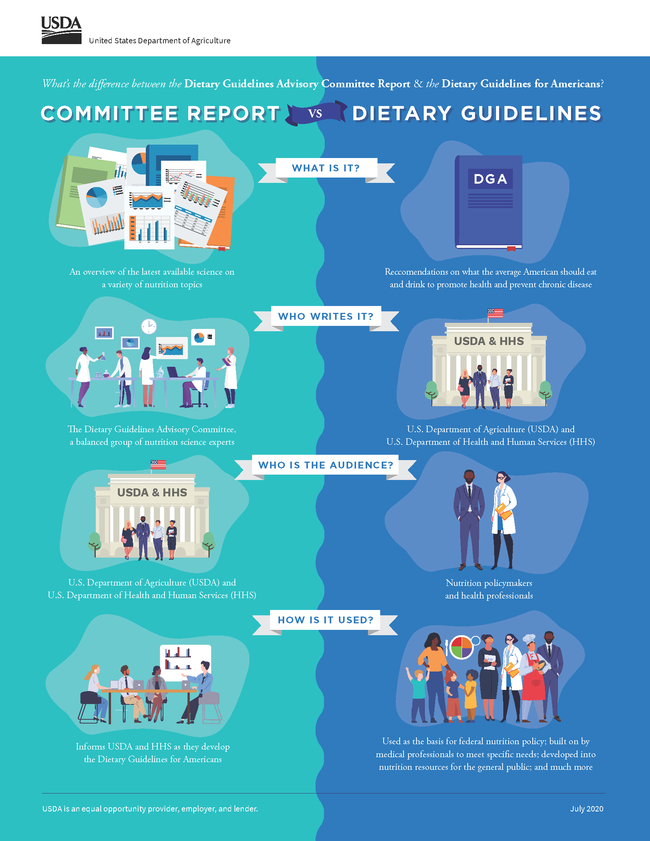We've probably all heard about the latest nutrition study. The one that says a certain kind of food may cause cancer. But what about the study from last month finding the same food may prevent hypertension? How about all of the different studies that find eating a certain way may help us lose weight? It can be hard to wade through the huge amount of information about diet and nutrition, even for nutrition professionals. The truth is that the study of diet and health, also known as nutritional epidemiology, is a highly complex field with huge barriers to conducting effective research. Emerging studies that provide new information can change what we think we know over time.
Given this complexity, wouldn't it be wonderful if there were a group of experts who regularly looked at all the research, then made recommendations on what generally makes the most sense for us to eat and drink? Trained nutrition researchers who filtered through each of the relevant topics and studies, weighed their evidence together as a whole, and advised us on how to balance the many competing concerns?
The good news for anyone trying to figure out how to eat healthfully is that this system already exists.
Every five years, the U.S. Department of Agriculture (USDA), in partnership with the U.S. Department of Health and Human Services (HHS), convenes a panel of some of the top nutrition researchers from around the country. These academic experts are tasked with reviewing the relevant studies and making recommendations to the USDA and HHS on what a healthy American diet should be. The current committee report, the Scientific Report of the 2020 Dietary Guidelines Advisory Committee, was recently released. The USDA and HHS will now take the information in the Scientific Report and use it to inform the official Dietary Guidelines for Americans, which are updated every five years. These guidelines affect nutrition standards and determine which foods are provided in federal national programs, from what school-children eat through the National School Lunch Program to what families with young children shop for through the Women, Infants and Children Program, and many other programs. The guidelines are also used by nutritionists and educators throughout the country to help increase people's knowledge of how to eat healthfully, including nutrition education taught to children and adults through the CalFresh Healthy Living, UC program and the Expanded Food and Nutrition Education Program.
It should be noted that the Scientific Report and the Dietary Guidelines themselves are designed to advise our entire population on how best to eat. The idea is that if everyone followed these recommendations, then we would see lower rates of diet-related chronic diseases overall in America, including cardiovascular disease, type 2 diabetes, certain types of cancers, and other diseases that develop over time. However, there are always going to be special considerations that some people need to make when choosing their food, related to health conditions, individual differences, or guidance from their medical providers. Even so, the expert recommendations are a good starting point to consider modifying in discussion with a registered dietitian or medical provider.
The 2020-2015 Dietary Guidelines will include something new. “For the first time ever, the committee considered the science to inform dietary guidelines for pregnant and lactating women and for infants and toddlers from birth to age 2,” said Christina Hecht, senior policy advisor for the UC Nutrition Policy Institute.
So, what else does the 2020 Scientific Report have to say? The full report is now publicly available to read online, and some of the highlights include:- The Committee recommends limiting added sugars to 6% or less of our daily calories, rather than 10%or less as is currently recommended.
- While this advisory committee was tasked with developing guidelines for pregnant and breastfeeding women for the first time, it found limited research on which to make specific recommendations. For pregnant women, the committee found, "Evidence suggests that consuming foods within healthy dietary patterns before and/or during pregnancy may modestly reduce the risk of gestational diabetes, hypertensive disorders of pregnancy, and preterm birth." More research in the area of diet and lactation/breastfeeding is needed.
- This advisory committee was also tasked with developing recommendations for infants and young children ages 0 to 24 months, and found some evidence that children who had ever been breastfed had lower rates of type 1 diabetes and asthma. The report highlighted the importance of feeding young children nutrient-dense foods in addition to breastmilk or infant formula. It further advises that children younger than 2 years old should not be given any sugar-sweetened beverages to drink and, in fact, should consume no added sugars.
- The committee found the longstanding advice that healthy diets "include higher intake of vegetables, fruits, legumes, whole grains, low- or nonfat dairy, lean meat and poultry, seafood, nuts, and unsaturated vegetable oils" is still supported by the evidence.
- The committee found the advice to replace saturated fats with unsaturated fats (but not necessarily with carbohydrates) is still supported by the evidence.
Read the full scientific report, learn more about the current Dietary Guidelines for Americans, or offer your own public comment on the process online by Aug. 13 at DietaryGuidelines.gov.
The National Drinking Water Alliance (coordinated at NPI) also has a website urging the addition of clear and actionable advice on drinking water to the Dietary Guidelines at https://www.drinkingwateralliance.org/submit-a-comment. The webpage includes tips on how to write an effective comment and the link to the comment submission page. Comments are due by Aug. 13.


